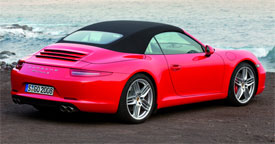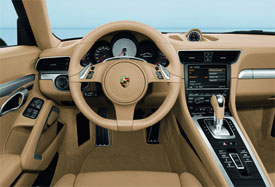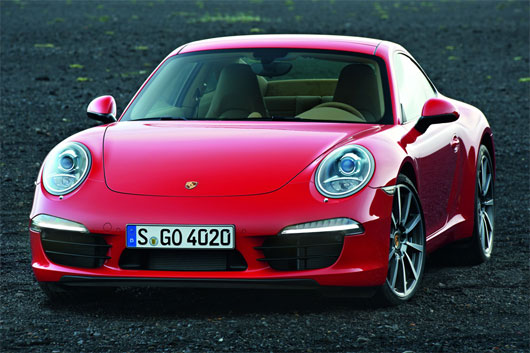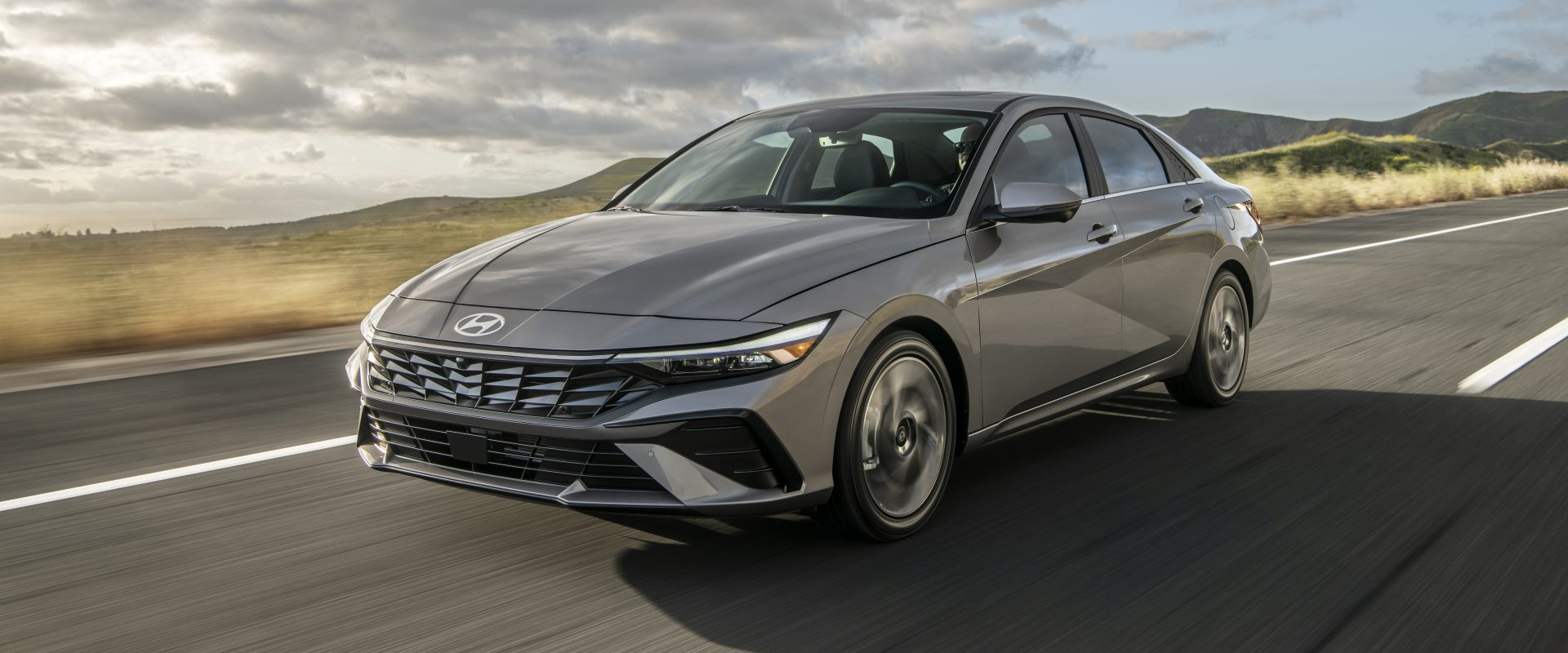2012 Porsche 911
An all new Porsche 911 is truly a rare thing, as there have been just 6 generations of the iconic sports car in its 48 years of production. The most recent 997 debuted in 2005 with not only increased performance, but more technology and luxury as well. Now this 7th generation 911 looks to bring even more of the cutting edge to this fabled label. But is this a car too far?
At first glance, it doesn’t appear like anything extreme, but the 2012 Porsche 911, dubbed the 991 is indeed all-new - as 90% of its parts are fresh. In silhouette, the iconic shape and sloping roofline are all there, but wheelbase has grown by 4-inches to 96.5, while overall length is up just one inch to 176.8. Roof height is down half an inch, front track is wider, larger air intakes dominate the front end, and bigger 20-inch wheels are standard on the Carrera S.
Bi-Xenon headlights are also standard, while corner lighting from the Dynamic Light System is optional. The new sunroof is a win-win. It slides over the top of the roof, and not inside it as before, allowing for both the lower overall height and additional headroom. Wide hips still dominate the rear view and new LED tail lights flash under hard braking to warn those following too closely. An active rear spoiler deploys automatically at 75 miles-per-hour.
 While the body is larger, it’s lighter than before, helping the 991, in Carrera S PDK trim, weigh in a tad less at 3,120 pounds. It’s difficult to tinker with an icon, making it look familiar, yet fresh. We feel Porsche has done a very good job with the new 911.
While the body is larger, it’s lighter than before, helping the 991, in Carrera S PDK trim, weigh in a tad less at 3,120 pounds. It’s difficult to tinker with an icon, making it look familiar, yet fresh. We feel Porsche has done a very good job with the new 911.
A heavily revised 3.8-liter flat-6 engine powers the Carrera S. Horsepower is up 15 to 400, while torque climbs 15 to 325 pound feet; the base Carrera gets a new, smaller 3.4-liter. Fuel economy is up in both engines by about 15%. Actual Government Fuel Economy Ratings for our PDK equipped Carrera S are 20-City and 27-Highway on Premium grade gas. Helping to achieve those numbers, is an all-new, industry first 7-Speed manual transmission; but, most buyers will opt for our car’s 7-Speed PDK automatic.
Acceleration is as spirited as you’d expect, with the PDK in Launch Mode, you can dispatch 60 in just 3.9-seconds; the quarter mile flies by in 12.1-seconds with a trap speed of 114 miles-per-hour. The 911 is certainly one high tech piece of machinery; there’s a lot of electronic assist, from Torque-Vectoring, electro-mechanical steering, Dynamic Chassis Control, and a downhill engine coasting function that disengages the PDK transmission. But unlike most rivals, everything happens so seamlessly you’re rarely aware of any intervention.
One thing we did notice is a new auto start/stop function. It works very well, and is also easily disabled, and it will turn off automatically when you engage Sport Mode. Sport Mode also ratchets up engine response, increases stability control threshold, gives the PDK more aggressive shifts, and stiffens up new dynamic engine mounts, which we found out at through the high speed corners of Savannah’s Roebling Road Raceway. Both front and rear suspensions have been redesigned and consist mostly of aluminum.
Brakes are both bigger and lighter, and Ceramic discs continue to be an option. Our car didn’t have them, but even after two days at the track, 100 foot super short stops from 60 were the norm.
 Despite its famous rear mounted engine, the new 911 is one of the most comfortable and forgiving sports cars ever. The interior has taken a bit of a sportier turn compared to the GT-car- like 997. Most controls lie in the “Panamera-inspired” center console that rises up to meet the dash, putting the shifter, just inches from the wheel.
Despite its famous rear mounted engine, the new 911 is one of the most comfortable and forgiving sports cars ever. The interior has taken a bit of a sportier turn compared to the GT-car- like 997. Most controls lie in the “Panamera-inspired” center console that rises up to meet the dash, putting the shifter, just inches from the wheel.
But, it’s not sparse. Just about every surface is covered in high quality leather, and plenty of luxury amenities are present. 7-inch, touch screen navigation is standard, as are power adjustments for both front seats. Rear seats are still more useful for luggage than people, and cargo capacity up front stays the same at 4.8 cubic-feet.
Gauges remain the classic 5-dial setup, with a large tach right in the middle and a dash mounted timer indicates you’ve opted for the Sport Chrono Package. A new Sound Symposer option lets you pipe additional ambiance into the cabin if you want to hear, as well as feel, the engines full wrath.
The 2012 Porsche 911 Carrera S is on sale now, with a price that is up slightly over last year to $97,350. The base Carrera rings in at $83,050.
Purists have given Porsche grief over the past few years for diversifying their line-up but selling all of those big sedans and SUV’s has just enabled them to make a much better 911. Sure, more and more electronics have creeped into the driving equation. But when they work this well, it’s hard to complain about them. So, if you have a chance, grab the wheel of a new 911, find some twisties, and enjoy the ride… We sure did!
Specifications
- Engine: 3.8-liter
- Horsepower: 400
- Torque: 325 lb-ft.
- 0-60 mph: 3.9-seconds
- 1/4 mile: 12.1 seconds @ 114 mph
- EPA: 20 mpg city/ 27 mpg highway
2024 Hyundai Elantra
Basic Transportation At Its Best…And That Is A Compliment
For those of you who write in every week bemoaning the fact that all we seem to do around here is test incredibly expensive cars and EVs that only the very well to do can afford, this one’s for you. It’s a commuter and budget friendly mainstay from Hyundai, the compact Elantra sedan. And, it has been nicely updated for 2024.
We clearly do enjoy driving high-performance machines and ultra-luxury rides around here, but like most of you, when it comes time to drive home at the end of a long workday, we do so in something much more practical and affordable, like this 2024 Hyundai Elantra sedan.
If you’re thinking the front end has gotten more aggressive, you’re right. Hyundai calls it a “Shark Nose” theme, and we’re guessing they were thinking more Great White than Hammerhead, though Megamouth shark would also apply. It helps for a low and wide look; more substantial than the typical compact. Other additions for ’24 include slimmer daytime running lights, revised stainless steel Hyundai emblem, reshaped front fenders, sport sedan-style rear diffuser with silver trim; a parametric pattern added to the C-Pillar, and new LED taillights that take up a lot more space on the highly sculpted decklid. Plus, new wheel designs in sizes ranging from 15- to 18-inches.
Standard engine in SE, SEL, and Limited grades is this naturally aspirated 2.0-liter I4 with 147 horsepower and 132 lb-ft of torque. Even with no hybrid assistance, it gets substantial Government Fuel Economy Ratings of 31 City, 40 Highway, and 34 Combined; we averaged a great 38.6 mpg of Regular.
Those high fuel economy numbers mean acceleration times are pretty high as well. It was in no particular hurry to get off the line at our test track, as after a slight jolt of power, it felt pretty sluggish going down the track, taking us a lengthy 9.4 seconds to hit 60 mph. Hyundai’s Intelligent Variable Transmission has some realistic simulated gear shifts built in, and they not only provided the feel of a true automatic, but kept engine noise from becoming overbearing. And while this 2.0-liter may not be a house-on-fire off the line, it has no problem keeping up with traffic, and feels like just the perfect amount of power for a practical and safe commuter car.
There are other engine options too. Two choices if you want to go faster, a 1.6-liter turbo with 201 horsepower in the Elantra N Line, and a 276-horsepower turbocharged 2.0-liter for the Elantra N; plus, one with even better fuel economy, a 1.6-liter hybrid with a 139 horsepower total output.
And despite some significant understeer, there was good feel through the cones of our handling course, both in steering and chassis feedback. We wouldn’t quite call it “point and shoot,” but it responded to inputs fairly quickly, with only moderate body roll. All-in-all, when it comes to performance, it doesn’t claim to bring a whole lot to the table, but does clearly overachieve with what it does bring.
And Hyundai is always overachieving when it comes to packing in features, yet has found a way of keeping things refreshingly simple with a good mix of touchscreen and manual controls. Lots of space too, both up front in the surprisingly wide front buckets, and in the rear bench with ample room for three. Updates for all Elantra interiors include softer materials on the door panels, upgraded instrumentation and additional charging ports, plus a surround view monitor and new H-Tex simulated leather for Limited trim.
Elantra pricing starts with an SE at $22,775, the SEL comes in at $24,725, Limited begins at $28,215, and the sporty N Line starts at $29,615. If you’re interested in the hybrid, base Blue starts at $27,400 with Limited at $30,600.
Some might say there’s not a whole lot that’s earth shaking about the 2024 Hyundai Elantra, but that’s mostly why we like it so much. When it comes to just delivering good, basic transportation with a high dose of unexpected amenities, Hyundai delivers once again.
Specifications
- Engine: 2.0-liter I4
- Horsepower: 147
- 0-60 mph: 9.4 seconds
- 60-0 Braking: 111 ft (avg)
- MW Fuel Economy: 38.6 MPG (Regular)
- Transmission: IVT
- Torque: 132 lb-ft
- 1/4 Mile: N/A (Track Maintenance)
- EPA: 31 City / 40 Highway / 34 Combined







